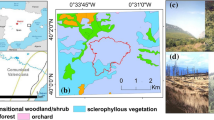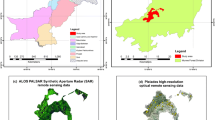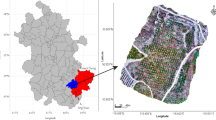Abstract
Several indices and simple empirical models and ratios of single band from pre- and post-fire Landsat images have been developed to estimate and/or map burn severity. However, these models and indices are usually site-, time- and vegetation-dependent and their applications are limited. The Daxing’an Mountains range has the largest forested area in China and is prone to wildfires. Whether or not the existing models can effectively characterize the burn severity over a large region is unclear. In this study, we used the orthogonal signal correction method based on partial least squares regression (PLSR) to select those variables that better interpret the variance of burn severity. A new index and other commonly used indices were used to construct a new, multivariate PLSR model which was compared with the popular single variable models, according to three assessment indices: relative root mean square error (RMSE%), relative bias (RE%) and Nash–Sutcliffe efficiency (NSE%). The results indicate that the multivariate PLSR model performed better than the other single variable models with higher NSE% (68.2% vs. 67.8%) and less RE% (3.7% vs. − 8.7%), while achieving almost the same RMSE%. We also discuss the spectral characteristics of the four selected variables for constructing the multivariate PLSR model and their correlation with the field burn severity data. The new model developed from this study should help to better understand the patterns of forest burn severity and assist in vegetation restoration efforts in the region.



Similar content being viewed by others
References
Arcenegui V, Mataix-Solera J, Zornoza R, Pérez-Bejarano A, Mataix-Beneyto J, Gómez I (2010) Estimation of the maximum temperature reached in burned soils using near-infrared spectroscopy: effects of soil sample pre-treatments. Geoderma 158:85–92
Carreiras JM, Pereira JM, Pereira JS (2006) Estimation of tree canopy cover in evergreen oak woodlands using remote sensing. For Ecol Manag 223:45–53
Chander G, Markham B (2003) Revised Landsat-5 TM radiometric calibration procedures and postcalibration dynamic ranges. IEEE Trans Geosci Remote Sens 41:2674–2677
Chander G, Markham BL, Helder DL (2009) Summary of current radiometric calibration coefficients for Landsat MSS, TM, ETM+, and EO-1 ALI sensors. Remote Sens Environ 113:893–903
Chu T, Guo X, Takeda K (2016) Temporal dependence of burn severity assessment in Siberian larch (Larix sibirica) forest of northern Mongolia using remotely sensed data. Int J Wildland Fire 25:685–698
Chuvieco E, Riaño D, Danson FM, Martin P (2006) Use of a radiative transfer model to simulate the postfire spectral response to burn severity. J Geophys Res 111:G04S09
Cocke AE, Fulé PZ, Crouse JE (2005) Comparison of burn severity assessments using differenced Normalized Burn Ratio and ground data. Int J Wildland Fire 14:189–198
De Santis A, Chuvieco E (2009) GeoCBI: a modified version of the Composite Burn Index for the initial assessment of the short-term burn severity from remotely sensed data. Remote Sens Environ 113:554–562
Epting J, Verbyla D, Sorbel B (2005) Evaluation of remotely sensed indices for assessing burn severity in interior Alaska using Landsat TM and ETM+. Remote Sens Environ 96:328–339
Eriksson HM, Eklundh L, Kuusk A, Nilson T (2006) Impact of understory vegetation on forest canopy reflectance and remotely sensed LAI estimates. Remote Sens Environ 103:408–418
Farifteh J, Van der Meer F, Atzberger C, Carranza E (2007) Quantitative analysis of salt-affected soil reflectance spectra: a comparison of two adaptive methods (PLSR and ANN). Remote Sens Environ 110:59–78
Fernández-Manso A, Fernández-Manso O, Quintano C (2016) SENTINEL-2A red-edge spectral indices suitability for discriminating burn severity. Int J Appl Earth Obs Geoinf 50:170–175
French NHF, Kasischke ES, Hall RJ, Murphy KA, Verbyla DL, Hoy EE, Allen JL (2008) Using Landsat data to assess fire and burn severity in the North American boreal forest region—an overview and summary of results. Int J Wildland Fire 17:443–462
Haire SL, McGarigal K (2009) Change in fire severity across grandients of climate, fire size and topography—a landscape ecological perspective. Fire Ecol 5:86–103
Hall RJ, Freeburn J, De Groot W, Pritchard J, Lynham T, Landry R (2008) Remote sensing of burn severity: experience from western Canada boreal fires. Int J Wildland Fire 17:476–489
Hernandez-Stefanoni JL, Ponce-Hernandez R (2006) Mapping the spatial variability of Plant diversity in a tropical forest: comparison of spatial interpolation methods. Environ Monit Assess 117(1–3):307–334
Höskuldsson A (2001) Variable and subset selection in PLS regression. Chemom Intell Lab Syst 55:23–38
Houborg R, Soegaard H, Boegh E (2007) Combining vegetation index and model inversion methods for the extraction of key vegetation biophysical parameters using Terra and Aqua MODIS reflectance data. Remote Sens Environ 106:39–58
Hudak A, Morgan P, Bobbitt M, Smith A, Lewis S, Lentile L, Robichaud P, Clark J, McKinley R (2007) The relationship of multispectral satellite imagery to immediate fire effects. Fire Ecol 3:64–90
Jakubauskas ME, Price KP (1997) Emperical relationships between structural and spectral factors of yellowstone lodgepole pine forests. Photogramm Eng Remote Sens 63:1375–1380
Jiang ZY, Huete AR, Chen J, Chen YH, Li J, Yan GJ, Zhang XY (2006) Analysis of NDVI and scaled difference vegetation index retrievals of vegetation fraction. Remote Sens Environ 101:366–378
Keeley JE (2009) Fire intensity, fire severity and burn severity: a brief review and suggested usage. Int J Wildland Fire 18:116–126
Key CH, Benson NC (2006) Landscape assessment (LA). FIREMON: fire effects monitoring and inventory system. General technical reports, RMRS-GTR-164-CD. US Department of Agriculture, Forest Service, Rocky Mountain Research Station, Fort Collins, CO
Langford K (1976) Change in yield of water following a bushfire in a forest of Eucalyptus regnans. J Hydrol 29:87–114
Larson AJ, Franklin JF (2005) Patterns of conifer tree regeneration following an autumn wildfire event in the western Oregon Cascade Range, USA. For Ecol Manag 218:25–36
Legates DR, McCabe GJ (1999) Evaluating the use of “goodness-of-fit” measures in hydrologic and hydroclimatic model validation. Water Resour Res 35:233–241
Lei CL, Ju CY, Cai TJ, Jing X, Wei XH, Di XY (2012) Estimating canopy closure density and above-ground tree biomass using partial least square methods in Chinese boreal forests. J For Res 23:191–196
LeMay V, Maedel J, Coops NC (2008) Estimating stand structural details using nearest neighbor analyses to link ground data, forest cover maps, and Landsat imagery. Remote Sens Environ 112(5):2578–2591
Lentile LB, Holden Z, Smith AMS, Falkowski MJ, Hudak AT, Morgan P, Lewis S, Gessler PE, Benson NC (2006) Remote sensing techniques to assess active fire characteristics and post-fire effects. Int J Wildland Fire 15:319–319
Liu X, Hu HQ, Li WH, Sun CK, Huang C, Zhao XK, Sun L (2014) Soil respiration rate and its seasonal variation of island forested swamp in cool temperate zone. Acta Ecol Sin 33:4356–7364
Lu X, Huang B, Yang SZ, Sun L, Guan D, Zhang R (2019) Causes and fighting characteristics of forest fire in Daxing’an mountains. J Northeast For Univ 47(11):77–80
Mahiny AS, Turner BJ (2007) A comparison of four common atmospheric correction methods. Photogramm Eng Remote Sens 73:361–368
Meng R, Wu J, Schwager KL, Zhao F, Dennison PE, Cook BD, Brewster K, Green TM, Serbin SP (2017) Using high spatial resolution satellite imagery to map forest burn severity across spatial scales in a Pine Barrens ecosystem. Remote Sens Environ 191:95–109
Miller JD, Thode AE (2007) Quantifying burn severity in a heterogeneous landscape with a relative version of the delta Normalized Burn Ratio (dNBR). Remote Sens Environ 109:66–80
Miller JD, Knapp EE, Key CH, Skinner CN, Isbell CJ, Creasy RM, Sherlock JW (2009) Calibration and validation of the relative differenced Normalized Burn Ratio (RdNBR) to three measures of fire severity in the Sierra Nevada and Klamath Mountains, California, USA. Remote Sens Environ 113:645–656
Morgan P, Keane RE, Dillon GK, Jain TB, Hudak AT, Karau EC, Sikkink PG, Holden ZA, Strand EK (2014) Challenges of assessing fire and burn severity using field measures, remote sensing and modelling. Int J Wildland Fire 23:1045–1060
Naesset E, Bollandsas OM, Gobakken T (2005) Comparing regression methods in estimation of biophysical properties of forest stands from two different inventories using laser scanner data. Remote Sens Environ 94:541–553
Nguyen HT, Lee BW (2006) Assessment of rice leaf growth and nitrogen status by hyperspectral canopy reflectance and partial least square regression. Eur J Agron 24:349–356
Quintano C, Fernandez-Manso A, Oberts DA (2017) Burn severity mapping from Landsat MESMA fraction images and land surface temperature. Remote Sens Environ 190:83–95
Rocchini D, Foody GM, Nagendra H, Ricotta C, Anand M, He KS, Amici V, Kleinschmit B, Förster M, Schmidtlein S, Feilhauer H, Ghisla A, Metz M, Neteler M (2013) Uncertainty in ecosystem mapping by remote sensing. Comput Geosci 50:128–135
Roy DP, Boschetti L, Trigg SN (2006) Remote sensing of fire severity: assessing the performance of the Normalized Burn Ratio. IEEE Geosci Remote Sens 3:112–116
Soverel NO, Perrakis DDB, Coops NC (2010) Estimating burn severity from Landsat dNBR and RdNBR indices across western Canada. Remote Sens Environ 114:1896–1909
Vyas D, Krishnayya NSR (2014) Estimating attributes of deciduous forest cover of a sanctuary in India utilizing Hyperion data and PLS analysis. Intl J Remote Sens 35:3197–3218
Wang Z (1987) The characteristics of extreme forest fire in Daxing’an Mountains and fire management strategies. For Fire Prev 4:3–7
Wang HW, Wu ZB, Meng J (2006) Partial least-squares regression: linear and nonlinear methods. National Defense Industry Press, Beijing
White J, Ryan K, Key C, Running S (1996) Remote sensing of forest fire severity and vegetation recovery. Int J Wildland Fire 6:125–125
Whitman E, Parisien MA, Thompson DK, Hall RJ, Skakun RS, Flannigan MD (2018) Variability and drivers of burn severity in the northwestern Canadian boreal forest. Ecosphere 9:e02128
Wold S, Martens H, Wold H (1983) The multivariate calibration problem in chemistry solved by the PLS method. In: Kågström B, Ruhe A (eds) Matrix Pencils. Lecture Notes in Mathematics, vol 973. Springer, Berlin
Wold S, Trygg J, Berglund A, Antti H (2001) Some recent developments in PLS modeling. Chemom Intell Lab Syst 58:131–150
Xu H (1998) Forest of Daxing’an Mountains in China. Science Press, Beijing
Yang G, Shu LF, Di XY (2012) Change trends of summer fire danger in Great Xing’an Mountains forest region of Heilongjiang Province, Northeast China under climate change. Chin J Appl Ecol 23(11):3157–3163
Zeng WZ, Huang JS, Xu C, Ma T, Wu JW (2016) Hyperspectral reflectance models for soil salt content by filtering methods and waveband selection. Ecol Chem Eng S 23:117–130
Zheng Z, Zeng Y, Li S, Huang W (2016) A new burn severity index based on land surface temperature and enhanced vegetation index. Int J Appl Earth Obs Geoinf 45:84–94
Acknowledgements
We are very grateful to the U.S. Geological Survey for providing the free remote sensing data. The authors also gratefully acknowledge anonymous reviewers for their patient comments.
Author information
Authors and Affiliations
Corresponding author
Ethics declarations
Conflict of interest
The authors declare that they have no conflict of interest.
Additional information
Publisher's Note
Springer Nature remains neutral with regard to jurisdictional claims in published maps and institutional affiliations.
Project funding: This research was partially supported by the Fundamental Research Funds for the Central Universities (DL12CA12, 2572017PZ05) and in part by the Research Foundation for Junior Teachers from the Ministry of Education of China (20110062120010).
The online version is available at http://www.springerlink.com.
Corresponding editor: Yu Lei.
Rights and permissions
About this article
Cite this article
Ju, C., Cai, T., Li, W. et al. Improving forest burn severity estimations with partial least squares regression and orthogonal signal correction methods in Daxing’an Mountains, China. J. For. Res. 32, 1157–1165 (2021). https://doi.org/10.1007/s11676-020-01178-8
Received:
Accepted:
Published:
Issue Date:
DOI: https://doi.org/10.1007/s11676-020-01178-8




